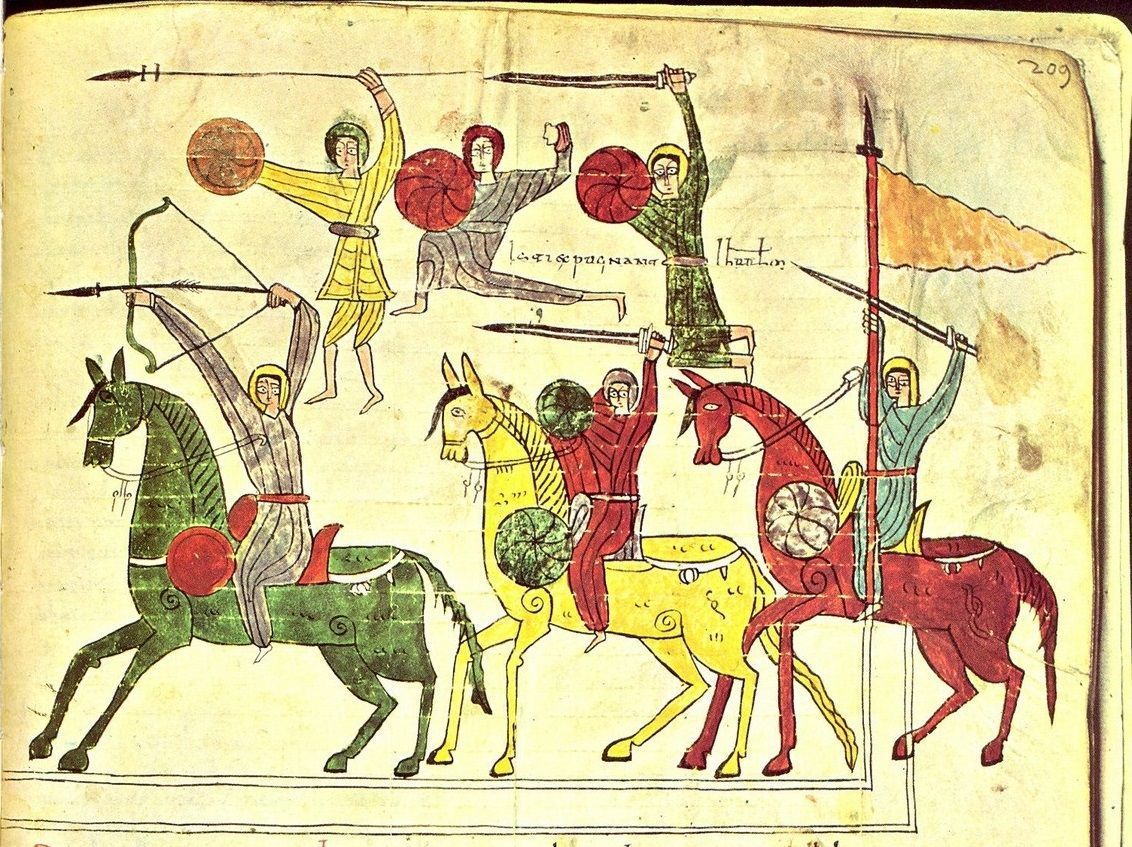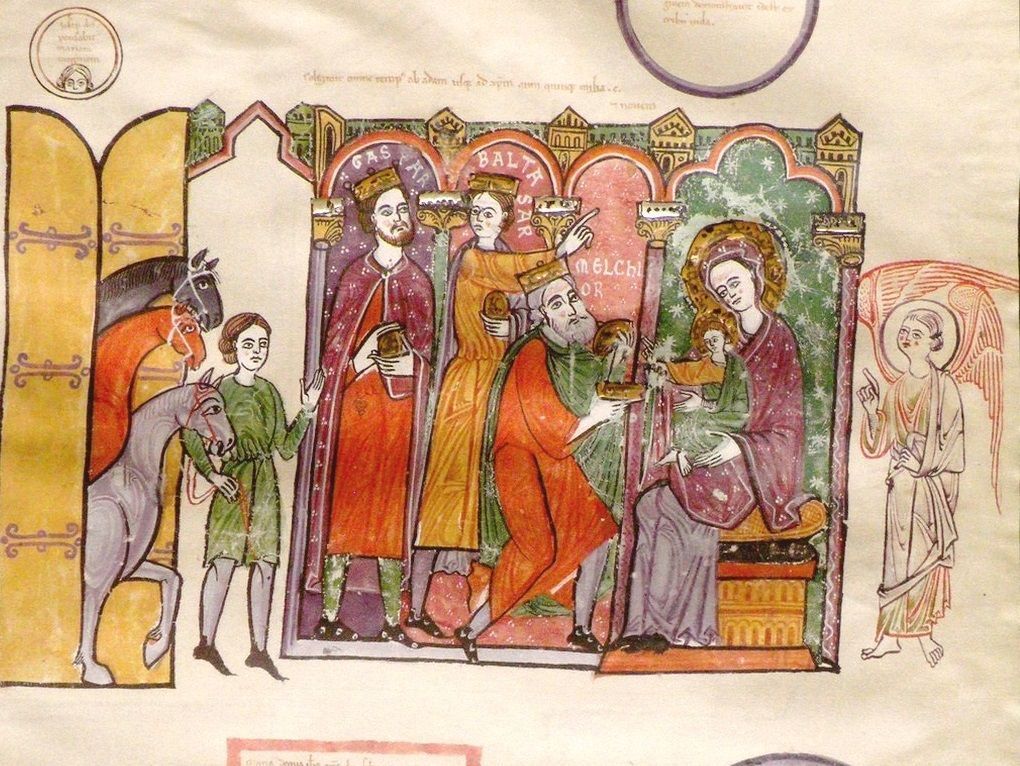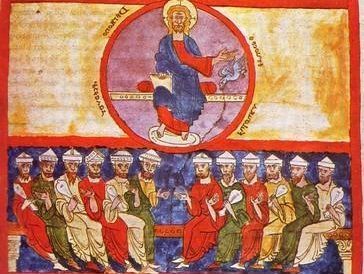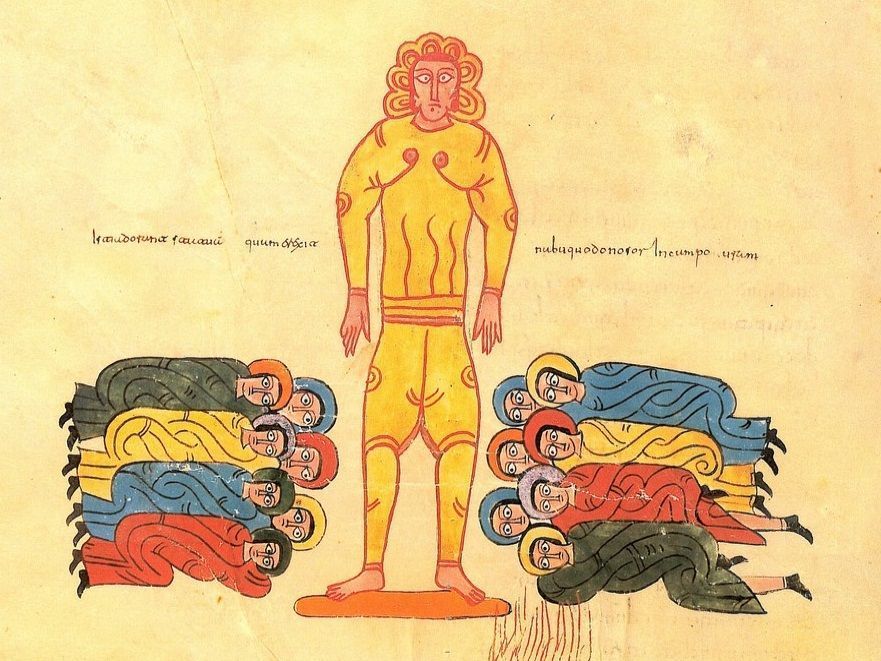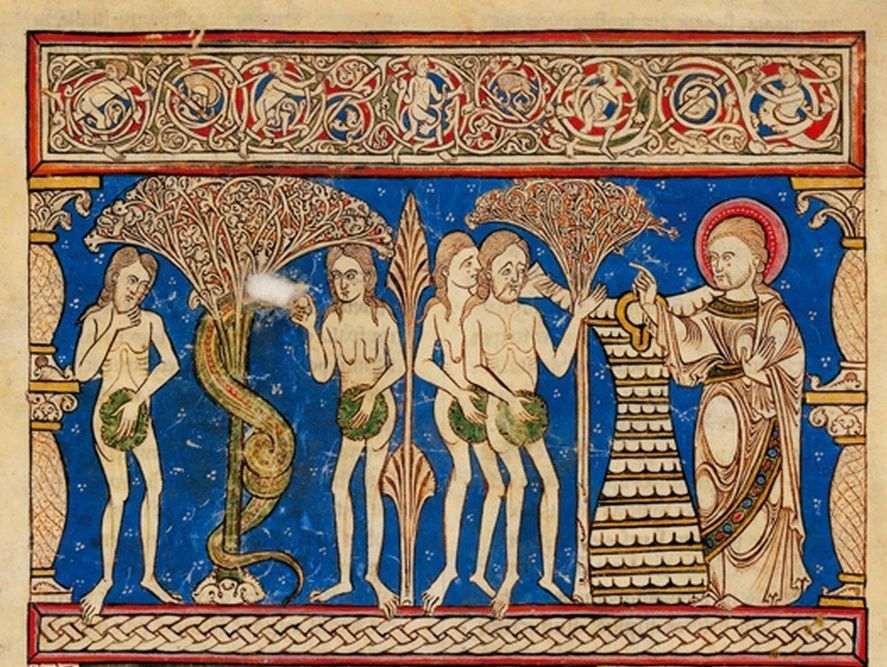General description of the manuscripts
BEATO DE LA SEO DE URGEL
Monastery of Valcavado? - 975 - Cathedral of Deo Urgel's Cathedral
From the end of the 10th century, it belongs to the same pictorial tradition of the Blessed of Escalada and Valcavado for which its is believed it was originated in the latter one. The manuscript consisting of 239 pages of 398 x 270 mm, seven pages numbered in Roman and 232 in Arab, written in rounded Visigothic typeface, with 79 miniatures, was already in its present location by the middle of the 12th century. From a stylistic viewpoint it is the most schematic of all Blessed of the 10th century.
BEATO DE LAS HUELGAS
San Pedro de Cardeña? - 1220 - Biblioteca Morgan, N. York
Its origin is unknown except it was commissioned by a lady, possibly for the Monastery of Las Huelgas and there is no doubt that it was copied from the Blessed of Tábara since, besides other coincidences, it is the only case with the image of Emeterio with the tower of Tábara. It is the largest blessed with 520 x 364 mm and consists of 187 pages and 116 miniatures, from a quarter to a double page that, respecting the iconographic structure of the original, show a naturalist style very close to the first Gothic miniature.
BEATO DE LORVAO
San Mamede de Lorvao monastery - 1189 - Torre del Tombo, Lisboa
Based largely in the considered as pictorial version I, it is the most completely preseved in this version. It is one of the latest blessed, most of them created in Cistercian monasteries, in this case, in St. Mamed of Lorvao’s, near Coimbra. The style of its miniatures, though clearly Romanesque, is not comparable to any other Spanish High Medieval codex. Simple pen and ink drawings on red and light yellow backgrounds, with very stylized and schematic figures standing out its essential lines.
BEATO DE MANCHESTER
Monastery of San Pedro de Cardeña? - 1189 - John Rylands Library,. Manchester
It consists of 510 pages of 442 x 313 mm, written in late Caroline pre Gothic typeface; it contains 123 full page beautiful miniatures illuminated with gold and silver. It is the only blessed that has reached us undamaged. Although it is of Romanesque style of the last period, with images of great quality, it maintains multiple horseshoe arches. For the ressemblance of its figures it is considered from the same series as the Blessed of St. Pedro de Cardeña, wth origin in Tabara’s, all three assigned to what is considered as family IIb.
BEATO DE NAVARRA
Unknown - Finales del siglo XII - Biblioteca Nacional, París
It is one of the last known blessed, with fully Romanesque miniatures and Caroline typeface in transition to Gothic. It seems it had been created for a church in Astorga, according to an indication on its world map. It is known that it stood in the Cathedral of Pamplona in 1665 and that it reached the National Library of France after moving hands among several owners. It is a very interesting codex, not only for its quality but also because it respects the structure of the original blessed from the 8th century from a very different viewpoint.
BEATO DE SAINT SEVER
Abbey of Saint Sever - Sobre el año 1050 - Biblioteca Nacional, París
It is the only copy of the Comments on the Apocalypsis of the Blessed of Liébana developed out of Spain, although for the scribe’s name, “Esteban García”, it can be affirmed that he was a Spanish monk. Made by a commission from the abbot of the Monastery of Saint-Sever, Grégoire de Muntaner, it consists of 292 pages of 365 x 280 mm with 108 miniatures, 84 of them recounted. Although it structure and the themes of its images adjust themselves to the version I of the Blessed, from 776, its artistic style is already quite different, totally Romanesque.
BEATO DE SAN ANDRES DEL ARROYO
San Pedro de Cardeña? - 1220 - Bibliothèque Nationale, París
Embedded in the family IIb, although in some points it seems to use a model from family I, consists of 334 pages of 300 x 457 mm, with 69 miniatures decorated in gold and silver. It corresponds to another blessed of the last phase commissioned by a Cistercian monastery, in this case feminine. Although it respects the structure of the traditional blessed, the artist includes several distinctive features, like the personalisation of the face and the apparel of each of the the figures in the miniatures with several characters, different to the usual practice of former models.
BEATO DE SAN PEDRO DE CARDEÑA
San Pedro de Cardeña - 1175/1185 - Museo Arq. Nacional, Madrid
It consists of 152 folios of 305 X 190mm, which are currently distributed in several places, most of them in the Archaeological Museum of Madrid. It includes 51 miniatures in which two different masters worked, both of great quality. His images are of great color, based on red, blue, green and gold plates, most inspired by the Blessed of Girona. Like Beato and Tábara among others, it follows the tradition of the version Iib, although it is a work of the last phase of the Romanesque miniature and already announces the Gothic.
Beato de Silos
Monastery of Silos - 1109 - The British Library, Londres
The monastery of Silos that in spite of its scriptorium had not produced any copy of the Blessed of Liébana’s Comments on the Apocalypsis along the 10th century, created this copy, finished in 1109, already in the midst of the Romanesque period. This codex, one of the most complete and best preserved, consists of 560 pages of 380 x 250 mm and 106 colourful miniatures, in an already Romanesque style, although continuing respresenting the arches in horseshoe shape.
BEATO DE TÁBARA
Mozarabic Monastery Leon - 970? - Archivo Histórico Nacional, Madrid
It is a 168 page codex of which only 10 miniatures out of 100 have been preserved, and four pages with genealogies. It includes the two last pages of another Blessed that was started by Magius and finished by Emeterio after his death with the help of the nun Ende, in the monastery of Tábara , for what the whole set receives the name by extension. The last page includes a miniature by Emeterio that we use as our anagram, where a part of the tower of the monastery may be appreciated and its monastery with several monks working.
BEATO DE TURIN
Some Catalan monastery - Principles of S. XII - Biblioteca Nazionale, Turín
Copy of the Blessd of Gerona in Caroline typeface of great quality, little after 1100 in a Catalonian scriptorium, possibly Ripoll. It consists of 214 pages in parchment of 360 x 275 mm and 106 miniatures with text to two columns and 42 lines per page. It maintains the structure of the Blessed of Gerona but with a different typsetting and colours, and modifying characters’ apparel to adjust them to the time it was copied.
BEATO DE VALCAVADO
Monastery of Valcavado - 970 - Biblioteca de la Universidad de Valladolid
It is one of the most interesting Pre Romanesque codex that has reached these days. It was illuminated by the monk Oveco for the abbot Sempronius from the monastery of St. Mary of Valcavado in 970, in just 92 days. Today it consists of 230 pages of 355 x 245 mm and contains 87miniatures of great beauty, magnificently coloured that are preserved in very good condition. Its technique, similar to that of the best Leonese codex of that period, is of great quality.
BEATUS DE SAN MIGUEL DE ESCALADA
San Salvador de Tábara - 945? - Morgan Library, New York Cab. 14-1
This manuscript, that it is also known as Blessed of Morgan and Blessed Magius, contains 299 pages and 89 miniatures. It was illuminated by Magius and belonged to the monastery of St. Miguel de Escalada, although its is possible that it really came from St. Salvador of Tábara, to which Magius belonged. Also its creation date is doubtful, since several authors place it in 922, 945 or 958. Nowadays, after many vicissitudes, it is located in the Morgan Library in New York.
BEATUS EMILIANENSE
Monastery of Valeránica ? - 930? - National Library (Madrid) Cab. 14-1
It is considered as the most ancient Blessed that has reached these days. It was preserved in the Monastery of St. Millán de la Cogolla, although it is possible that it may have been illuminated in another scriptorium. It consists of 144 pages of 350 x 250 mm in 27 miniatures, with over 70 pages disappeared. It is written in Visigothic typesetting, following the text considered to be the most ancient version of the Blessed’s comment, dated in 776, supposedly extremely close with regard to the iluminated prototype in times of the Blessed.
BIBLIA DE AVILA
Ávila Cathedral - Finales del S. XII - Biblioteca Nacional, Madrid
With its 600 x 425mm and nearly 15 kg weight, it is the largest Bible ever to reach us. It consists of two perfectly differentiated parts, the first created in some monastery of the centre of Italy in the second half of the twelfth century. At the end of that century it reached Avila, where it was finished. The illustrations of this second phase are not of great quality but they have an enormous expressive force and great dynamism, with characters and compositions that reflect an enormous pathos, both in the expression of the faces and in the treatment of the figures.
BIBLIA DE BURGOS
San Pedro de Cardeña? - 1175 - Biblioteca Públca del Estado, Burgos
A completely Romanesque work although maintaining the Hispanic inspiration, this manuscript with its 404 pages in parchment that correspond to the New Testament, as the rest has been lost, is considered as one of the most beautiful codex from the Romanesque, specially emphasising its miniatures on the Adoration of the Kings and the Genesis. Its compositions include, with great harmony, figures of elongated canon with shorter ones, interspersing in many of them different episodes in the same page with great fluidity and aesthetics sense.
Biblia de Cardeña
San Pedro de Cardeña - 912? - Universidad Pontificia de San Jerónimo de Burgos
It has 397 pages, written to two columns of 52 lines drawn with stamp; the text filling some 335 x 105 mm. More than twenty pages have been lost and many preserved ones have been damaged. It contains the Old and New Testaments plus some appendix, among which the prologue of St. Isidore points out. The type setting is Visigothic in lower case of a very good quality, with the initials of every book always heavily decorated whereas the initials of the chapters are smaller and with less decoration.
BIBLIA DE PAMPLONA
Pamplona - 1200 - Bibl. Univ. de Augsburgo
It is a manuscript with very special characteristics that starting from a version of the original Vulgata, contains 976 pen and ink illustrations, watercolured, that fill half or full pages, to which a footnote with the texts in Gothic lower case typeface was added later. It includes the Old and New Testament as well as representations of numerous saints and an appendix with texts from the Apocryphal Gospels related to the second coming of Christ.
BIBLIA DE RIPOLL
Monastery of Ripoll - 1015-1020 - Vatican Library
Also called the Farfa Bible because initially its origin was attributed to this monastery, there is currently no doubt that it was created in the Ripoll, as demonstrated by Pijoán and Neuss analyzing its similarities with the Roda Bible and with the doorway of the monastery of Ripoll. With a wide content, which in addition to the Old and New Testaments, includes a multitude of biblical texts, it is one of the codices of its time with a greater number of illustrations.
BIBLIA DE RODA
Monastery of Ripoll - 1010-1015 - Biblioteca Nacional, París
It is one of the three great bibles created in the monastery of Ripoll under the direction of the abbot Oliva, together with the one disapperared in a fire in 1835 and the Bible of Ripoll. The style developed in this monastery, although maintaining the spirit of all the Spanish High Medieval miniature, presents a broader Carolingian and Byzantine influx and a greater classicism. It consists of four volumes, the first two decorated with coloured images and the following two, only with lines in black and contains the most complete illustration known on the text of the prophets.
- « Previous
- 1
- 2
- 3
- 4
- Next »



